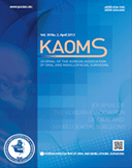Journal of the Korean Association of Oral and Maxillofacial Surgeons
- P-ISSN2234-7550
- E-ISSN2234-5930
- SCOPUS, KCI, ESCI
 ISSN : 2234-7550
ISSN : 2234-7550
Tilted implants for implant-supported fixed hybrid prostheses: retrospective review
Pil-Young Yun (Department of Oral and Maxillofacial Surgery, Section of Dentistry, Seoul National University Bundang Hospital, Seongnam)
Na-Hee Chang (Department of Dental Hygiene, Section of Dentistry, Gangdong University, Eumseong)
Young-Kyun Kim (Department of Oral and Maxillofacial Surgery, Section of Dentistry, Seoul National University Bundang Hospital)
Abstract
Objectives: This review assessed the performance of implant-supported fixed hybrid prostheses in 21 patients who received a total of 137 implants between 2003 and 2010. The implants were evaluated for marginal bone resorption, complications, success rate, and survival rate based on their vertical angularity, type of bone graft, and measured implant stability. Materials and Methods: One-way ANOVA and chi-square tests were used to analyze the relationships among long-term evaluation factors and these variables. The mean initial bone resorption in the implant group with a vertical angle of more than 20° was 0.33 mm and mean final bone resorption was 0.76 mm. In contrast, the mean initial bone resorption in the implant group with a vertical angle of less than 10° was 1.19 mm and mean final bone resorption was 2.17 mm. Results: The results showed that mean bone resorption decreased with an increase in the vertical placement angle of the implants used in fixed hybrid prostheses, as well as in the group without additional bone grafts and those with high implant stability. The success rate of implants placed after bone grafting was found to be higher than those placed simultaneously. Conclusion: These results suggest that implant-supported fixed hybrid prostheses may be an effective treatment option for edentulous patients, and intentionally placing implants with high angularity may improve outcomes.
- keywords
- Implant-supported dental prosthesis, Dental implant, Bone transplantation, Bone resorption
- 44다운로드 수
- 159조회수
- 0KCI 피인용수
- 0WOS 피인용수